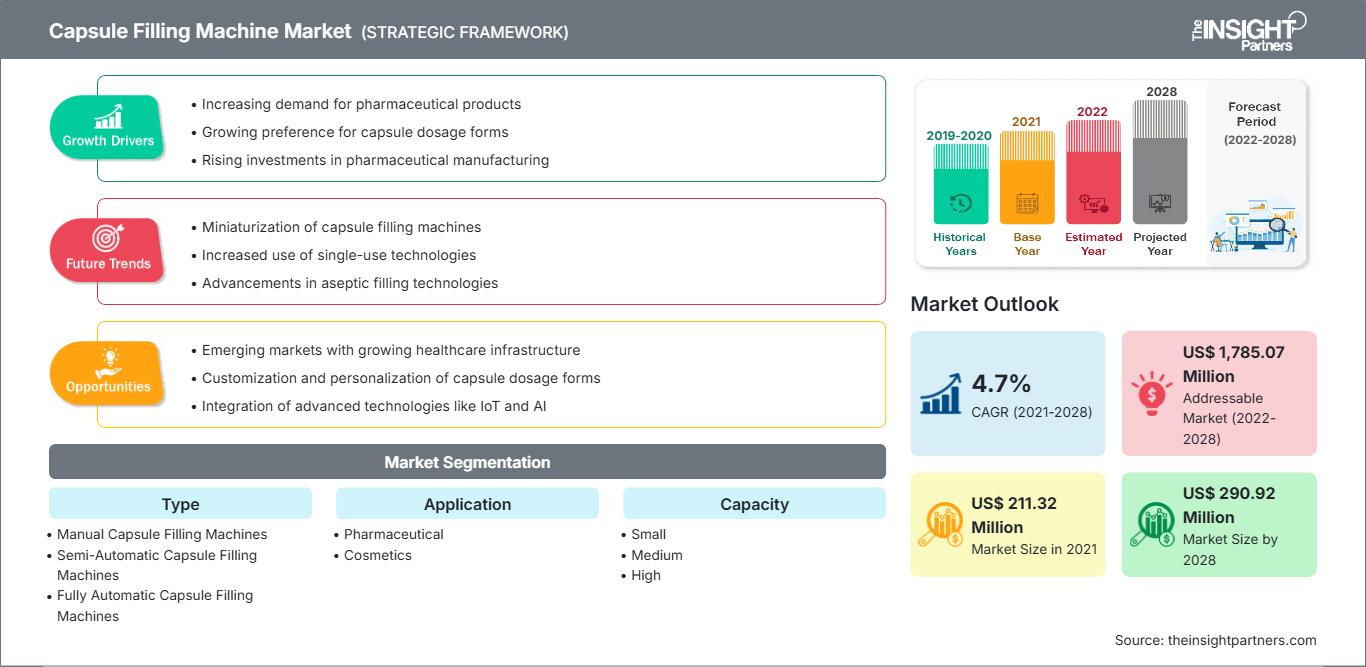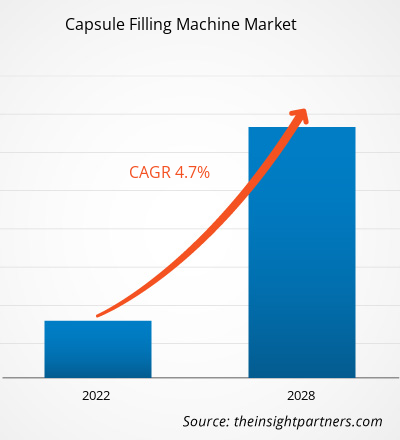[Rapport de recherche] Le marché des machines de remplissage de gélules devrait atteindre 290,92 millions de dollars américains d'ici 2028, contre 211,32 millions de dollars américains en 2021 ; sa croissance devrait atteindre un TCAC de 4,7 % entre 2021 et 2028.
Les machines de remplissage de gélules, également appelées machines d'encapsulation, sont des dispositifs mécaniques largement utilisés à des fins pharmaceutiques et industrielles. Ces machines remplissent des gélules vides, molles ou dures, de différentes tailles, avec des poudres, des granulés, des semi-solides ou des liquides contenant des principes actifs pharmaceutiques ou une combinaison de principes actifs pharmaceutiques et d'excipients. Ces machines sont utilisées dans un large éventail d'industries, telles que la chimie, la pharmacie, l'alimentation animale et l'agroalimentaire. Pour différents types de remplisseuses de gélules, il existe environ 1 600 installations dans le monde.
La croissance du marché des machines de remplissage de gélules est due aux progrès de ces machines et à la prévalence croissante des maladies chroniques. Cependant, le coût élevé de leur production freine la croissance du marché.
Personnalisez ce rapport en fonction de vos besoins
Vous bénéficierez d’une personnalisation sur n’importe quel rapport - gratuitement - y compris des parties de ce rapport, ou une analyse au niveau du pays, un pack de données Excel, ainsi que de profiter d’offres exceptionnelles et de réductions pour les start-ups et les universités
Marché des machines de remplissage de capsules: Perspectives stratégiques

- Obtenez les principales tendances clés du marché de ce rapport.Cet échantillon GRATUIT comprendra une analyse de données, allant des tendances du marché aux estimations et prévisions.
Vous bénéficierez d’une personnalisation sur n’importe quel rapport - gratuitement - y compris des parties de ce rapport, ou une analyse au niveau du pays, un pack de données Excel, ainsi que de profiter d’offres exceptionnelles et de réductions pour les start-ups et les universités
Marché des machines de remplissage de capsules: Perspectives stratégiques

- Obtenez les principales tendances clés du marché de ce rapport.Cet échantillon GRATUIT comprendra une analyse de données, allant des tendances du marché aux estimations et prévisions.
Aperçu du marché : La prévalence croissante des maladies chroniques stimule le marché des machines de remplissage de gélules
La prévalence croissante des maladies chroniques, telles que les maladies cardiovasculaires (MCV), le cancer, le diabète, les accidents vasculaires cérébraux et les maladies rénales, a accru la demande de machines de remplissage de gélules pour faciliter la production de gélules médicinales. Selon l'OMS, les maladies cardiovasculaires sont la principale cause de décès dans le monde, tuant 17,9 millions de personnes chaque année. De plus, la prévalence croissante du diabète a accru le besoin de gélules médicinales, entraînant une demande accrue de machines de remplissage de gélules. Selon la neuvième édition de l'Atlas du diabète de la Fédération internationale du diabète, environ 463 millions d'adultes (âgés de 20 à 79 ans) souffraient de diabète en 2019, et ce chiffre devrait atteindre 700 millions d'ici 2045. La prévalence croissante du cancer stimule également la demande de machines de remplissage de gélules. Selon l'OMS, le cancer est la deuxième cause de décès dans le monde, avec 9,6 millions de décès en 2018. L'augmentation des cas de maladies rénales chroniques dans le monde a également accru le besoin de médicaments quotidiens, ce qui se reflète dans la croissance du marché. L'Institut national du diabète et des maladies digestives et rénales a indiqué dans un rapport que plus de 661 000 Américains souffraient d'insuffisance rénale en 2018, dont 468 000 nécessitaient une dialyse et un traitement quotidien. En raison de la fréquence croissante des maladies chroniques et des infections, la demande de produits pharmaceutiques augmente rapidement, soulignant l'importance des machines de remplissage de gélules.
Informations basées sur les types
Le marché des machines de remplissage de gélules, par type, est segmenté en machines de remplissage de gélules manuelles, machines de remplissage de gélules semi-automatiques et machines de remplissage de gélules entièrement automatiques. Français Le segment des machines de remplissage de gélules entièrement automatiques détenait la plus grande part du marché en 2021. De plus, ce même segment devrait enregistrer le TCAC le plus élevé du marché au cours de la période de prévision.
Informations basées sur les applications
Par application, le marché des machines de remplissage de gélules est segmenté en produits pharmaceutiques, cosmétiques et autres. En 2021, le segment pharmaceutique détenait la plus grande part du marché. De plus, ce segment devrait enregistrer la plus forte entre 2021 et 2028.
Informations basées sur la capacité
Le marché des machines de remplissage de gélules, par capacité, est segmenté en petites (jusqu'à 50 000 gélules), moyennes (50 000 à 100 000 gélules par heure) et élevées (plus de 100 000 gélules par heure). En 2021, le segment des petites capsules (jusqu'à 50 000 gélules) détenait la plus grande part de marché. De plus, ce segment devrait enregistrer son TCAC le plus élevé, soit 5,0 %, entre 2021 et 2028.
Le lancement et l'approbation de nouveaux produits sont des stratégies courantes adoptées par les entreprises pour étendre leur présence mondiale et leur portefeuille de produits. De plus, les acteurs du marché des machines de remplissage de capsules privilégient les partenariats pour élargir leur clientèle, ce qui leur permet de maintenir leur image de marque à l'international.
Marché des machines de remplissage de capsules
Les tendances régionales et les facteurs influençant le marché des machines de remplissage de gélules tout au long de la période de prévision ont été analysés en détail par les analystes de The Insight Partners. Cette section aborde également les segments et la répartition géographique du marché des machines de remplissage de gélules en Amérique du Nord, en Europe, en Asie-Pacifique, au Moyen-Orient et en Afrique, ainsi qu'en Amérique du Sud et en Amérique centrale.Portée du rapport sur le marché des machines de remplissage de capsules
Attribut de rapport
Détails
Taille du marché en 2021
US$ 211.32 Million
Taille du marché par 2028
US$ 290.92 Million
TCAC mondial (2021 - 2028)
4.7%
Données historiques
2019-2020
Période de prévision
2022-2028
Segments couverts
By Type - machines de remplissage de capsules manuelles
- machines de remplissage de capsules semi-automatiques
- machines de remplissage de capsules entièrement automatiques
By Application- pharmaceutique
- cosmétique
By Capacité- petite
- moyenne
- élevée
Régions et pays couverts
Amérique du Nord- États-Unis
- Canada
- Mexique
Europe- Royaume-Uni
- Allemagne
- France
- Russie
- Italie
- reste de l'Europe
Asie-Pacifique- Chine
- Inde
- Japon
- Australie
- reste de l'Asie-Pacifique
Amérique du Sud et centrale- Brésil
- Argentine
- reste de l'Amérique du Sud et centrale
Moyen-Orient et Afrique- Afrique du Sud
- Arabie saoudite
- Émirats arabes unis
- reste du Moyen-Orient et de l'Afrique
Leaders du marché et profils d'entreprises clés - ACG
- Capsugel, Inc (A subsidiary of Lonza Group AG)
- Dott. Bonapace & C. srl
- Schaefer Technologies
- Syntegon Technology GmbH
- Torpac Inc.
- Zhejiang Fuchang Machinery Co., Ltd
- Beijing Hanlin Hangyu Technology Development Inc.
- M2G S.r.l
Densité des acteurs du marché des machines de remplissage de capsules : comprendre son impact sur la dynamique commerciale
Le marché des machines de remplissage de gélules connaît une croissance rapide, portée par une demande croissante des utilisateurs finaux, due à des facteurs tels que l'évolution des préférences des consommateurs, les avancées technologiques et une meilleure connaissance des avantages du produit. Face à cette demande croissante, les entreprises élargissent leur offre, innovent pour répondre aux besoins des consommateurs et capitalisent sur les nouvelles tendances, ce qui alimente la croissance du marché.
- Obtenez le Marché des machines de remplissage de capsules Aperçu des principaux acteurs clés
Marché des machines de remplissage de capsules
Les tendances régionales et les facteurs influençant le marché des machines de remplissage de gélules tout au long de la période de prévision ont été analysés en détail par les analystes de The Insight Partners. Cette section aborde également les segments et la répartition géographique du marché des machines de remplissage de gélules en Amérique du Nord, en Europe, en Asie-Pacifique, au Moyen-Orient et en Afrique, ainsi qu'en Amérique du Sud et en Amérique centrale.Portée du rapport sur le marché des machines de remplissage de capsules| Attribut de rapport | Détails |
|---|---|
| Taille du marché en 2021 | US$ 211.32 Million |
| Taille du marché par 2028 | US$ 290.92 Million |
| TCAC mondial (2021 - 2028) | 4.7% |
| Données historiques | 2019-2020 |
| Période de prévision | 2022-2028 |
| Segments couverts |
By Type
|
| Régions et pays couverts | Amérique du Nord
|
| Leaders du marché et profils d'entreprises clés |
|

- Obtenez le Marché des machines de remplissage de capsules Aperçu des principaux acteurs clés
Profils d'entreprise
- ACG
- Capsugel, Inc (filiale de Lonza Group AG)
- Schaefer Technologies
- Syntegon Technology GmbH
- Torpac Inc.
- Zhejiang Fuchang Machinery Co.
- Ltd ; Beijing Hanlin Hangyu Technology Development Inc.
- M2G Srl ;
- IMA Industria Macchine Automatiche SpA
- Analyse historique (2 ans), année de base, prévision (7 ans) avec TCAC
- Analyse PEST et SWOT
- Taille du marché Valeur / Volume - Mondial, Régional, Pays
- Industrie et paysage concurrentiel
- Ensemble de données Excel
Rapports récents
Rapports connexes
Témoignages
Raison d'acheter
- Prise de décision éclairée
- Compréhension de la dynamique du marché
- Analyse concurrentielle
- Connaissances clients
- Prévisions de marché
- Atténuation des risques
- Planification stratégique
- Justification des investissements
- Identification des marchés émergents
- Amélioration des stratégies marketing
- Amélioration de l'efficacité opérationnelle
- Alignement sur les tendances réglementaires




















 Obtenez un échantillon gratuit pour - Marché des machines de remplissage de capsules
Obtenez un échantillon gratuit pour - Marché des machines de remplissage de capsules